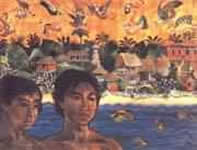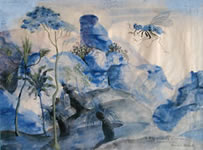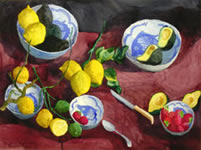 Former long term Bali expat, Donald Friend was one of the most important foreign artists to live in Bali. Donald Stuart Leslie Friend (6 February 1915 – 16 August 1989) was an Australian artist, writer and diarist.
Former long term Bali expat, Donald Friend was one of the most important foreign artists to live in Bali. Donald Stuart Leslie Friend (6 February 1915 – 16 August 1989) was an Australian artist, writer and diarist.
Born in Sydney, precociously talented both as an artist and a writer, Friend grew up in the artistic circle of his bohemian mother. He studied with Sydney Long (1931) and Dattilo Rubbo (1934-1935), and later in London (1936-1937) at the Westminster Art School with Mark Gertler and Bernard Meninsky. During World War II he served as a gunner with the AIF, and while stationed at Albury began an important friendship with Russell Drysdale which was to culminate in their joint discovery of Hill End, a quasi-abandoned gold mining village near Bathurst, New South Wales, which was to become something of an artists’ colony in the 1950s. He also served as an official war artist in Labuan and Balikpapan in 1945. After the war he lived for a time in the Sydney mansion-cum-boarding house Merioola, exhibiting with the so-called Merioola Group.
 Much of Friend’s life and career were spent outside Australia, in places as diverse as Nigeria (late 1930s, where he served as financial advisor to the Ogoga of Ikerre), Italy (several visits in the 1950s), Sri Lanka (late 1950s-early 1960s, from whence dates this view of the city of Colombo), and Bali from 1968 until his final return to Sydney in 1980. Much – all – of this travel was in search of a sophisticated simplicity which Australian reality could not provide. Nor, in the event, could any of the Edens he attempted: each ended in disillusionment, the Apollonian forever unreconciled with the Dionysian.
Much of Friend’s life and career were spent outside Australia, in places as diverse as Nigeria (late 1930s, where he served as financial advisor to the Ogoga of Ikerre), Italy (several visits in the 1950s), Sri Lanka (late 1950s-early 1960s, from whence dates this view of the city of Colombo), and Bali from 1968 until his final return to Sydney in 1980. Much – all – of this travel was in search of a sophisticated simplicity which Australian reality could not provide. Nor, in the event, could any of the Edens he attempted: each ended in disillusionment, the Apollonian forever unreconciled with the Dionysian.
Donald Friend’s reputation in the 1940s stood beside those of William Dobell and Russell Drysdale; by the time of his death it had sunk so far that he was totally missing from the 1988 Bicentennial exhibition, a show meant to include every artist of importance since white settlement. The fall from critical grace began in the mid-1950s, with Australia’s somewhat belated discovery of non-figurative abstract art. Friend – and to a lesser extent Drysdale and Dobell – suffered from their adherence to an earlier, mannered modernism based in the figurative tradition. But for Friend, rejection by the critics (not the public, with whom his postcards from Paradise remained ever popular), except for a few champions like critic Robert Hughes, was made the more acute by what was seen as the frivolity and self-indulgence of his work and life.
 Friend was essentially a pagan, bereft of any sense of sin or guilt, reveling in sensuality and colour, and making no attempt to disguise the homo-eroticism which underlay much of his work – which makes the more surprising the fact that he won the Blake Prize for religious art in 1955. Nor did he mince words about his attractions, depicting himself in his journal as “a middle-aged pederast who’s going to seed”. His relationships consisted in large part of a series of relations with adolescent boys, some of whom remained as life-long friends, particularly Attilio Guarracino and others who merely fleeced the artist for whom they had modeled.
Friend was essentially a pagan, bereft of any sense of sin or guilt, reveling in sensuality and colour, and making no attempt to disguise the homo-eroticism which underlay much of his work – which makes the more surprising the fact that he won the Blake Prize for religious art in 1955. Nor did he mince words about his attractions, depicting himself in his journal as “a middle-aged pederast who’s going to seed”. His relationships consisted in large part of a series of relations with adolescent boys, some of whom remained as life-long friends, particularly Attilio Guarracino and others who merely fleeced the artist for whom they had modeled.
Perhaps less surprising is the fact that his exhibitions were several times raided by the Vice Squad – his was an age in which the police still took an interest in culture. Donald Friend’s brilliance as a figure draughtsman is universally recognized, (a brilliance exercised especially on studies of the young male nude), as also is his wit and his decorative gift. His facility as a draughtsman may have contributed to the undervaluing of his work – “[It] has always looked too easy – decorative, flowing and natural,” according to art scholar Lou Klepac. Robert Hughes, writing in the mid-1960s, described him as “one of the two finest draughtsmen of the nude in Australia,” and noted his humanism and lack of sentimentality, while still concluding that he was not a major artist. Barry Pearce, however, writing in the study which accompanied Friend’s posthumous retrospective at the Art Gallery of New South Wales in 1990, commented that Hughes’ judgement seemed harsh and called for a re-evaluation of Friend as an artist whose “contribution to the richness of Australian art is due for much greater recognition.”
In addition to his work as an artist Friend published a number of illustrated books, almost all in limited editions, displaying the same wit and sensuality which informs much of his art. The National Library of Australia has began editing and publishing the half-million words of the journals Friend kept since he was 14, and which provide a record of his life and times, peopled by such important figures as Drysdale, Margaret Olley, Jeffrey Smart, Brett Whiteley and others.
John Moyle has an excellent article about the Bali lifestyle of Donald Friend. An interesting read about an influential Bali expat.
Donald Friend’s work is on display at the ARMA and Neka galleries among others.